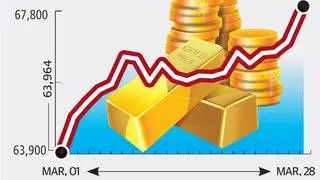Is the price compass pointing north for iron ore? Iron ore has been on a long downward since touching $150 a tonne in early 2013. Prices touched a multi-year low in 2015 but have been in recovery mode, at around $58 a tonne currently. But data points to high supply weighing down prices in the near term.
Weak demandIron ore prices jumped in the first half of 2016, aided by demand from China. Bloomberg analysis shows that steel mills in the country accelerated production in this period, aiding ore price increase. Iron ore imports in China, the consumer of two-thirds of the world’s seaborne supplies, increased 9 per cent year-on-year through May 2016.
But Chinese steel production declined in the first half of 2016, indicating lack of iron ore demand in the second half of the year. Ore imports in 2016 are likely to be lower than the earlier two years — 920 million tonnes in 2016, compared with 953 million tonnes and 933 million tonnes in 2015 and 2014, respectively, according to China Iron & Steel Association.
A report from the Australian Government agency also points to the fact that some of the iron ore demand may have been speculative. Futures volume traded on the Dalian Commodities Exchange in China is said to have increased rapidly, exceeding half a billion tonnes on 32 occasions during February-April 2016. As a result, spot price for iron ore from Australia traded between $40 and $66 a tonne in this period.
Globally, steel demand growth has been sluggish. The World Steel Association expects that global demand will grow 0.2 and 0.5 per cent year-on-year, respectively, in 2016 and 2017. Demand had contracted 0.3 per cent last year to 1.5 billion tonnes.
But, in spite of sluggish demand and iron-ore prices plunging over 32 per cent last year, the big three producers — BHP Billiton, Rio Tinto and Vale — increased production. Data from Bloomberg shows that production increased as the miners found that increased scale drives efficiencies and lowers cash costs.
Together, it points to falling iron ore prices over the rest of 2016 due to stronger supply growth and weak demand growth. Forecasts for 2017 from Australia, the world’s largest exporter of iron ore, have been lowered to $44 a tonne, down from its $55 a tonne prediction earlier. Futures market price projection from Bloomberg points to a drop to $43 a tonne (from $51 currently) while analysts estimate $45 a tonne.
Indian scenarioThe metal dynamics in India has often diverged from the global scenario in the past due to local issues. For example, during 2012 and 2014, when a mining ban was imposed in States such as Goa and Karnataka, local prices climbed. Prices have, however, been sluggish since 2015 as many mines resumed production. State-owned NMDC cut the price of its high-grade ore by 10 per cent and lower grade ore by 12 per cent in April 2016. Prices of higher grade ore were further reduced by 5.5 per cent in June 2016.
Prices were increased in October — by 23.5 per cent per wet metric tonne (WMT) for lumps and 20.5 per cent for fines. However, analysis by ICRA shows that inventory levels in India are high and production is increasing, thanks to mining bans being lifted. NMDC also plans to increase output — to about 35 million tonnes (mt) in 2016 from 28 mt in 2015. Its total ore production is projected to increase to 50 mt by 2018-19 and 67 mt by 2021-22.
Compared to the bleak global steel demand, the Indian situation is expected to be robust. The World Steel Association predicts demand in India will grow by 5.4 per cent annually in both 2016 and 2017. However, ICRA data shows that ore production in the country is increasing at a fast clip — 23 per cent in 2015-16 and estimated at about 10 per cent in 2016-17 (to 170 mt). This could dent local prices, going forward.








Comments
Comments have to be in English, and in full sentences. They cannot be abusive or personal. Please abide by our community guidelines for posting your comments.
We have migrated to a new commenting platform. If you are already a registered user of TheHindu Businessline and logged in, you may continue to engage with our articles. If you do not have an account please register and login to post comments. Users can access their older comments by logging into their accounts on Vuukle.